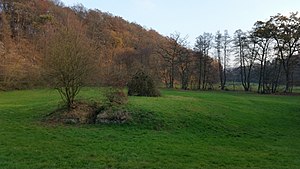Ravenstein Castle
| Ravenstein Castle | ||
|---|---|---|
|
Remains of Ravenstein Castle |
||
| Alternative name (s): | Ravensteyn Castle | |
| Creation time : | Medieval | |
| Castle type : | Niederungsburg, moth | |
| Conservation status: | Burgstall, small remains | |
| Construction: | Quarry stone | |
| Place: | Ravenstein | |
| Geographical location | 50 ° 44 '28 " N , 7 ° 23' 46" E | |
| Height: | 142 m above sea level NHN | |
|
|
||
The castle Ravenstein is an Outbound medieval motte (Motte) in the village of Ravenstein . It belongs to the urban area of Hennef (Sieg) in the North Rhine-Westphalian Rhein-Sieg district .
topography
The ruins of Ravenstein Castle are located on a pasture by the Ravensteiner Bach, not far from the Ravensteiner Mühle (also known as the Klingermühle). The centerpiece of the castle was a quarry stone tower with a square floor plan of around 6 × 6 meters. The remains of the wall that have been preserved reveal the former entrance to the castle.
The tower stood on a heaped hill and was surrounded by a moat that no longer exists today.
The oldest known pictorial representation of the castle ruins comes from a watercolor from 1861.
Towards the end of the 19th century, the approximately 10-meter-high remains of the ruin, which had already fallen into disrepair, were removed to expand the stables and cellars of the neighboring mill.
history
Ravenstein was a knight's seat . The earliest documented mention is in the Bodinger Memorienbuch from 1450. A Knape Philipp Roys and his wife Heylwigis von Ravenstein are mentioned in the entry. Ravenstein was later the seat of an aristocratic family, with a seat in the Düsseldorf state parliament .
Legend
According to a local legend, the robber baron Junker Möcher, who had made a pact with the devil, lived in the castle. According to legend, the devil fulfills his every wish in exchange for his soul. When the junker was dying, he asked his wife to rub honey over herself and to roll in goose feathers. She should sit on the entrance gate, fletched like this. When the devil comes, the Junker's last wish is that the devil tell him what kind of bird is sitting on his gate. The devil cannot answer this question and so breaks the pact with the Junker, whose soul belongs to him again.
literature
- Fischer, Helmut (1983): The legendary figure of Junker Möcher. The knight seat Ravenstein . In: Heimatblätter des Rhein-Sieg-Kreis 51/52, pp. 7–21. Pp. 7-21, o. O.
- Renard, Edmund / Clemen, Paul (ed.): The Rittersitz Ravenstein. History, legend, meaning . In: Contributions to the history of the city of Hennef-Sieg 4, p. 36 and p. 40 f., Hennef.
- Zimmermann, Walther u. a. (1970): The Art Monuments of the Siegkreis. (Die Kunstdenkmäler der Rheinprovinz V, 4th) p. 261, Düsseldorf.
- Handbook of Historic Places in Germany , Volume 3. P. 724, Stuttgart.
Web links
- Entry on Niederungsmotte Burg Ravenstein in the database " KuLaDig " of the Rhineland Regional Association
- Entry by Jens Friedhoff on Ravenstein Castle in the scientific database " EBIDAT " of the European Castle Institute
Individual evidence
- ↑ a b Dominique Müller-Grote, Reinhard Zado: Hennef - City of 100 Villages, Ten Ways to Discover the City of Hennef, Edition Blattwelt, Niederhofen 2006, ISBN 3-936256-26-8
- ↑ Helmut Fischer: Narrating - Writing - Interpretation , Der Junker von Ravenstein , Waxmann Verlag, ISBN 978-3830910367



